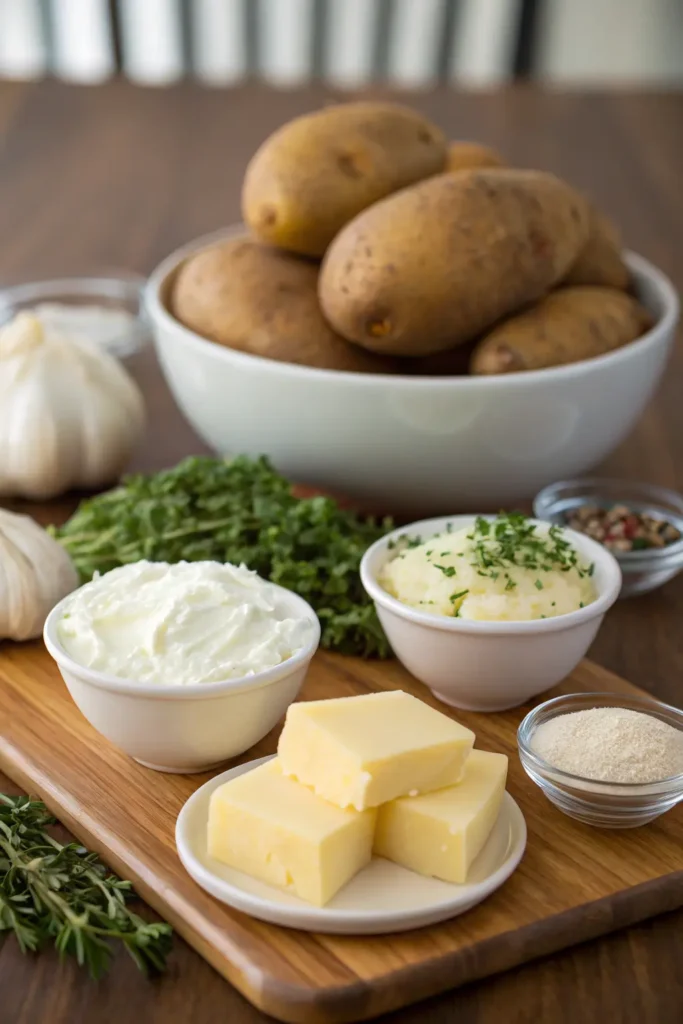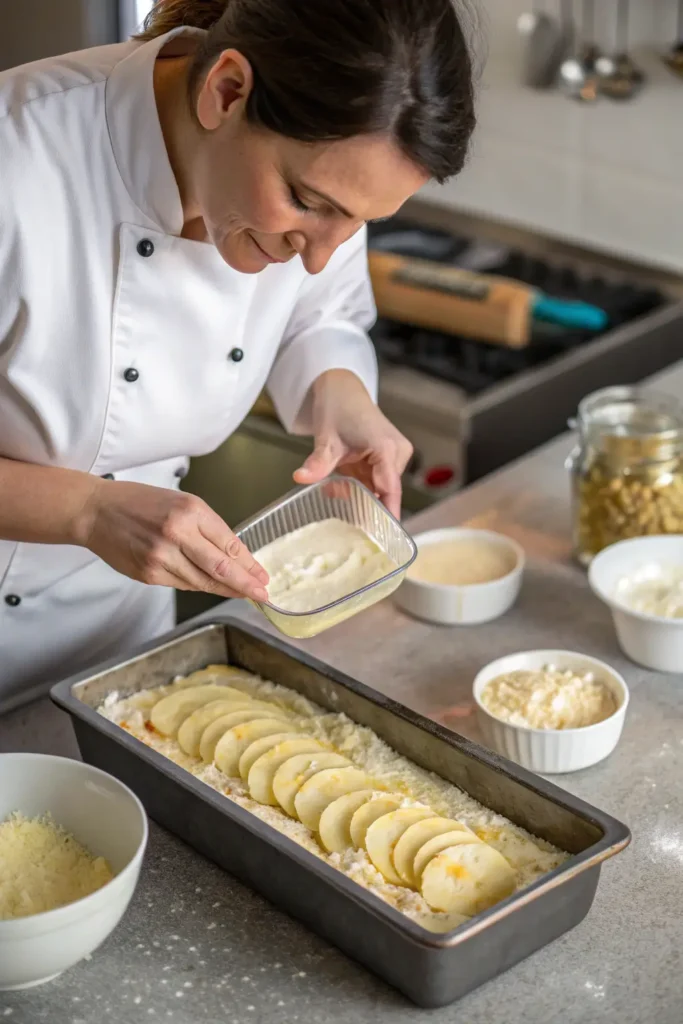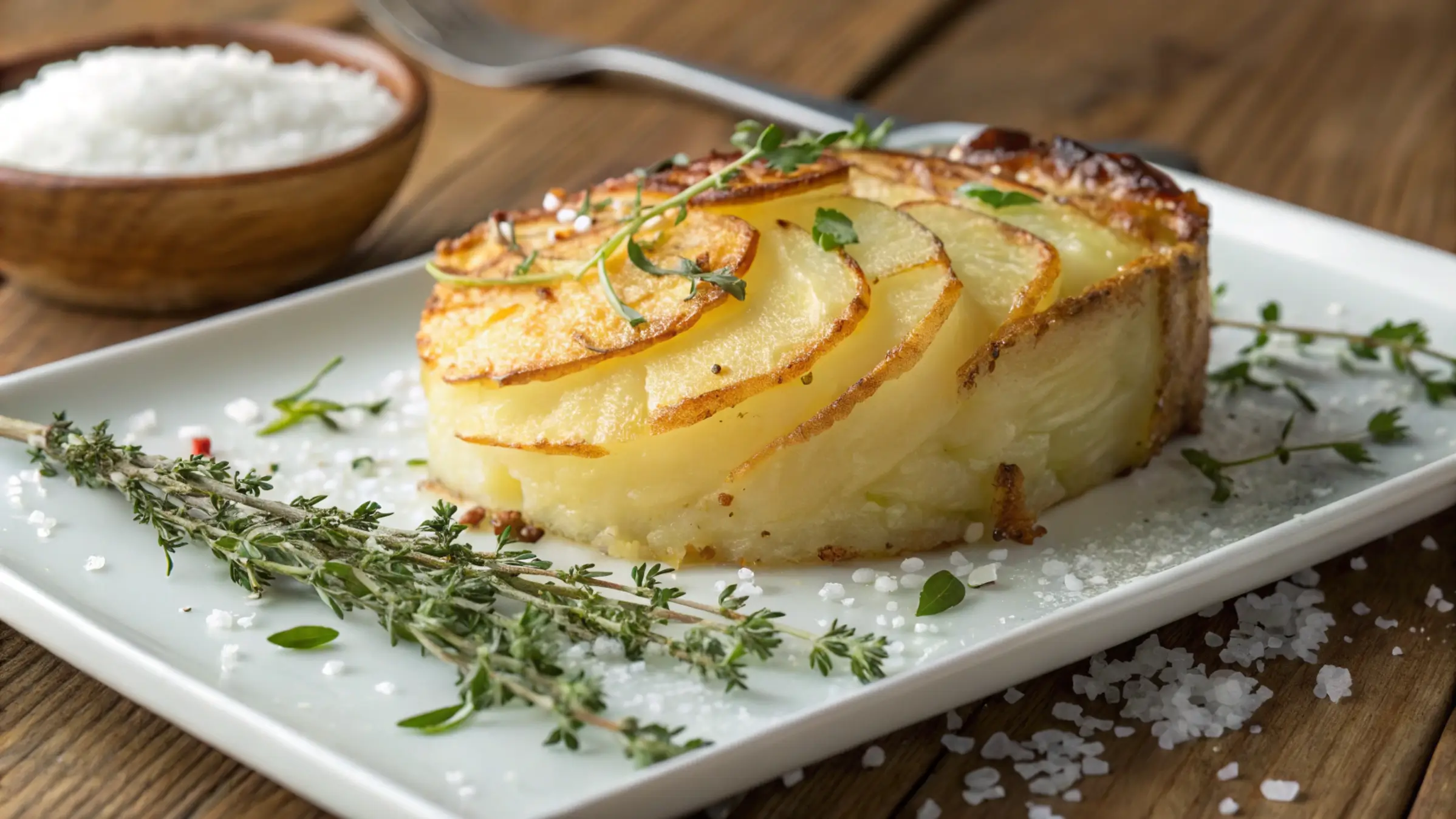Potato Pave is a sophisticated yet surprisingly simple dish that turns ordinary potatoes into a crispy, buttery, and layered masterpiece. With its precise slicing, careful stacking, and slow baking process, this French-inspired delicacy delivers an irresistible combination of crisp golden edges and a creamy interior.
Originally derived from pommes pavé, which translates to “paved potatoes,” this dish resembles cobblestone-like layers of thinly sliced potatoes that are compressed, baked, and pan-fried for a perfect crisp. Whether served as an elegant side dish or a showstopping appetizer, Potato Pavé elevates any meal with its refined texture and rich flavor.
In this guide, you’ll learn how to master Potato Pavé like a professional chef. From selecting the right potatoes and slicing them uniformly to compressing the layers and achieving the perfect crispiness, this step-by-step approach will ensure flawless results every time. Get ready to create a restaurant-worthy dish in your own kitchen!
Table of Contents
Potato Pave: Key Benefits
Potato Pavé isn’t just visually impressive—it’s a dish packed with flavor, texture, and versatility. Here are the key benefits of mastering this elegant potato recipe:
1. Crispy on the Outside, Creamy on the Inside
One of the most satisfying aspects of Potato Pavé is its textural contrast. The slow baking process allows the layers to soften and absorb the seasoned butter and cream mixture, creating a rich, velvety center. Once pan-fried, the exterior turns beautifully crisp, adding a delightful crunch to every bite.
2. A Versatile Side Dish for Any Occasion
Potato Pavé pairs well with a variety of main courses, from roasted meats to delicate seafood dishes. Whether you’re serving it at an upscale dinner party or alongside a casual home-cooked meal, it’s a dish that elevates any plate.
3. Make-Ahead Convenience
Since this dish requires chilling before frying, it’s an excellent make-ahead option. You can prepare the layers in advance, refrigerate overnight, and crisp them up just before serving. This not only saves time but also enhances the structure of the pave, ensuring it holds together beautifully.
4. Customizable Flavors
While the classic version relies on butter, cream, and sea salt, you can easily customize Potato Pavé to suit different tastes. Add parmesan for a nutty depth, fresh thyme for an herby aroma, or a dollop of crème fraîche for a tangy contrast.
5. A Restaurant-Quality Dish at Home
Potato Pavé is a staple in fine dining, but you don’t need to be a professional chef to make it. By following the right techniques—like using a mandolin for uniform slices and compressing the layers properly—you can achieve the same high-end results in your own kitchen.
Potato Pave: Ingredients

To create a perfect Potato Pavé, you need simple yet high-quality ingredients that enhance the dish’s texture and flavor. Below is a carefully curated list to ensure the best results.
Main Ingredients:
- 4 large russet potatoes – Ideal for their high starch content, which helps the layers hold together.
- 1 cup heavy cream – Adds richness and helps bind the potatoes.
- ½ cup unsalted butter, melted – Provides flavor and crispiness.
- ½ cup grated parmesan – Enhances the dish with a subtle nuttiness.
- 1 teaspoon sea salt – Brings out the natural potato flavor.
- ½ teaspoon black pepper – Adds a mild heat and balance.
- ½ teaspoon fresh thyme leaves (optional) – Infuses an aromatic touch.
- ½ teaspoon garlic powder (optional) – Deepens the savory profile.
For Baking and Finishing:
- Parchment paper – Prevents sticking and ensures even cooking.
- Aluminum foil – Helps retain moisture while baking.
- Heavy cans or a weighted loaf pan – Used to compress the layers for a firm texture.
- 2 tablespoons vegetable oil – For pan-frying and achieving a crispy exterior.
- Flaky sea salt (for garnish) – Adds a delicate crunch and enhances the final presentation.
Optional Garnishes:
- Chopped chives – A fresh, mild onion flavor that complements the rich potatoes.
- Crème fraîche or sour cream – A tangy contrast to balance the dish’s richness.
- Caviar (for an upscale twist) – A luxurious addition for special occasions.
These ingredients ensure the perfect balance of crispiness, creaminess, and flavor. Up next, I’ll guide you through the step-by-step process of making Potato Pavé.
Potato Pave: Instructions

Mastering Potato Pavé requires precision in slicing, layering, and compressing. Follow these step-by-step instructions to achieve a perfectly crispy and creamy dish.
Step 1: Prepare the Baking Dish
- Line a 9-inch loaf pan with parchment paper, leaving enough overhang on the sides to cover the top later.
- Brush the parchment paper with melted butter to prevent sticking.
Step 2: Slice the Potatoes
- Peel the russet potatoes and use a mandolin to slice them into paper-thin (⅛-inch) slices. A mandolin ensures even layers, which is crucial for consistency.
- Place the sliced potatoes in a large bowl and toss them with heavy cream, melted butter, sea salt, black pepper, parmesan, and optional thyme or garlic powder. Make sure each slice is coated evenly.
Step 3: Layer the Potatoes
- Start layering the potatoes in the loaf pan, overlapping each slice slightly. Press each layer down gently to remove air pockets.
- Continue layering until all the potatoes are used. Pour any remaining cream mixture over the top for added moisture.
- Fold the overhanging parchment paper over the potatoes.
Step 4: Bake and Compress
- Cover with aluminum foil and place a heavy can or another loaf pan on top to compress the layers. This ensures a tight, compact texture.
- Bake in a preheated oven at 350°F (175°C) for 1½ hours, or until the potatoes are tender and the layers hold together.
- Remove from the oven and cool at room temperature for 30 minutes before transferring to the refrigerator.
Step 5: Chill and Slice
- Refrigerate for at least 4 hours (or overnight) to set the layers. This makes slicing easier.
- Once fully chilled, lift the Potato Pavé out of the pan using the parchment paper overhang.
- Place it onto a cutting board and slice into even rectangles or squares.
Step 6: Pan-Fry for a Crispy Finish
- Heat vegetable oil in a small saucepan or skillet over medium heat.
- Fry each slice for 2-3 minutes per side until golden brown and crispy.
- Transfer to a paper towel-lined plate to absorb excess oil.
Step 7: Garnish and Serve
- Sprinkle with flaky sea salt for extra crunch.
- Garnish with chopped chives, crème fraîche, or even caviar for a luxurious touch.
Now that you’ve prepared the perfect Potato Pavé, let’s explore some pro tips and variations to customize this dish to your taste.
Potato Pave: Pro Tips and Variations
Mastering Potato Pavé requires attention to detail. These pro tips and variations will help you achieve the best texture, flavor, and presentation while allowing you to customize the dish to your preference.
Pro Tips for the Perfect Potato Pavé
1. Use the Right Potatoes
Russet potatoes work best due to their high starch content, which helps the layers hold together. Yukon Gold can be used for a creamier texture, but they may not crisp up as well.
2. Slice Uniformly for Even Cooking
Using a mandolin ensures each slice is the same thickness. Uneven slices can lead to inconsistent textures, with some parts cooking faster than others.
3. Press the Layers Firmly
Compression is key. Use a heavy can or another loaf pan to weigh down the potatoes during baking. This removes air gaps and helps the layers stick together.
4. Chill for at Least 4 Hours
Refrigerating the pavé allows the structure to set, making slicing easier. For the best results, chill overnight.
5. Fry in Hot Oil for Maximum Crispiness
Ensure the oil is heated properly before frying. If the oil is not hot enough, the pavé will absorb too much and become greasy instead of crisp.
6. Season in Layers
Lightly season each layer as you stack the potatoes. This ensures an even distribution of flavor throughout the dish.
Flavor Variations
1. Parmesan and Herb Infusion
Add extra parmesan between the layers for a deeper, nutty flavor. Mix in fresh thyme, rosemary, or chives for a fragrant touch.
2. Garlic Butter Pavé
Infuse the butter with minced garlic before brushing it onto the potatoes. This adds a rich, savory element that pairs well with meats.
3. Truffle Pavé
Drizzle truffle oil over the layers before baking or finish the dish with truffle salt for an upscale twist.
4. Spiced Pavé
For a bolder flavor, sprinkle in smoked paprika, cayenne pepper, or ground nutmeg between the layers.
5. Cheese-Lover’s Pavé
Use a blend of gruyère, cheddar, or gouda for an extra cheesy variation. These cheeses melt beautifully into the layers.
6. Sweet Potato Pavé
Swap russet potatoes for sweet potatoes for a naturally sweet version. Pair with cinnamon and nutmeg for a holiday-inspired side dish.
With these tips and variations, you can experiment to create a version of Potato Pavé that suits your taste and occasion.
Potato Pave: Serving Suggestions
Potato Pavé is an elegant and versatile dish that pairs well with a variety of meals. Whether served as a side or a gourmet appetizer, these serving ideas will help you make the most of its crispy texture and rich flavor.
Pairing with Main Dishes
1. Steak and Red Meat
Potato Pavé complements grilled or pan-seared steaks, lamb chops, and beef tenderloin. The crispy exterior and creamy layers balance the bold flavors of red meat.
2. Roast Chicken and Poultry
Serve alongside roast chicken, duck confit, or turkey. The buttery potatoes pair well with herb-seasoned poultry dishes.
3. Seafood Dishes
Pair with seared salmon, pan-fried scallops, or grilled shrimp for a refined meal. A drizzle of lemon butter enhances the dish’s flavors.
4. Vegetarian Entrées
Potato Pavé works as a hearty vegetarian side with roasted vegetables, sautéed mushrooms, or a creamy spinach dish. It also pairs well with a mushroom sauce or truffle oil.
Plating and Presentation
1. Fine Dining Style
For an elegant presentation, slice the pavé into precise squares or rectangles and arrange them neatly on the plate. Garnish with chopped chives, flaky sea salt, or a drizzle of crème fraîche.
2. Casual and Rustic
Serve on a wooden platter or cast-iron skillet for a rustic look. Pair with a side of garlic aioli or herbed butter.
3. Party or Appetizer Option
Cut into bite-sized cubes and serve as an appetizer with toothpicks and dipping sauces like sour cream or a garlic-infused aioli.
Garnishing Ideas
- Flaky sea salt – Enhances the crispy texture.
- Fresh thyme or rosemary – Adds a fragrant touch.
- Parmesan shavings – Boosts the umami flavor.
- Caviar and crème fraîche – Elevates the dish for special occasions.
- Black truffle shavings – Adds a luxurious finish.
With its crispy, golden exterior and creamy center, Potato Pavé can turn any meal into a restaurant-quality experience.
Conclusion
Potato Pave is more than just a side dish—it’s a carefully crafted combination of crispy texture and creamy layers that elevate any meal. By mastering the slicing, layering, and compression techniques, you can create a dish that rivals those found in top restaurants.
This versatile recipe allows for endless variations, from herb-infused layers to truffle-infused finishes. Whether served alongside a perfectly seared steak, delicate seafood, or as an appetizer at a gathering, Potato Pave delivers a sophisticated touch to any occasion.
With the right ingredients, proper technique, and attention to detail, you can confidently prepare this dish at home. Experiment with flavors, refine your method, and enjoy the satisfaction of creating a dish that is both visually impressive and delicious.
Next, let’s address some frequently asked questions to help you perfect your Potato Pave.

Mastering Potato Pave: A Chef’s Guide to Slicing and Stacking
Ingredients
- 4 large russet potatoes (Peeled and thinly sliced)
- 4 tbsp unsalted butter (Melted)
- ½ cup heavy cream
- ¼ cup whole milk
- ½ cup grated Parmesan cheese
- 2 tsp fresh thyme (Chopped)
- 2 cloves garlic (Minced)
- to taste salt
- to taste black pepper
- 2 tbsp olive oil (For frying)
- as desired sprigs fresh thyme or rosemary (For garnish (optional))
- as desired flaky sea salt (For garnish (optional))
Instructions
- Preheat your oven to 350°F (175°C). Grease a 9-inch loaf pan with butter or cooking spray.In a medium bowl, combine heavy cream, whole milk, minced garlic, fresh thyme, salt, and black pepper. Stir well and set aside.Arrange the sliced potatoes in the loaf pan in slightly overlapping layers. After each layer, pour a bit of the cream mixture over the potatoes, followed by a sprinkle of grated Parmesan cheese.Once all the potatoes are layered, cover the pan with aluminum foil. Place a heavy object (like a small pan or a baking sheet) on top to compress the layers. Bake for 1 hour.After 1 hour, remove the foil and bake for another 30 minutes, until the top is golden and crispy.Remove from the oven and allow the pavé to cool for 15-20 minutes. Then, refrigerate for at least 4 hours to set.Once chilled, carefully remove the pavé from the loaf pan and slice it into rectangular or square pieces.Heat olive oil in a skillet over medium-high heat. Fry the sliced potato pavé until golden and crispy, about 2-3 minutes per side.Transfer the fried slices to a paper towel-lined plate to remove excess oil.Garnish with flaky sea salt and fresh thyme (optional). Serve immediately and enjoy!
Notes
- Layering Tip: Be sure to overlap the potato slices slightly to ensure the layers hold together well during baking and frying.
- Chilling Time: Allowing the potato pavé to chill for at least 4 hours (or overnight) helps it set properly, making it easier to slice and fry.
- Crispiness: For extra crispiness, you can fry the potato pavé slices a little longer, but be careful not to burn them.
- Alternative to Frying: If you prefer a healthier option, you can bake the sliced pavé at 400°F (200°C) for about 15-20 minutes until golden and crispy instead of frying.
- Customization: You can add other herbs like rosemary or sprinkle some grated cheese between the layers for extra flavor.
- Storage: Leftover potato pavé can be stored in the refrigerator for up to 3 days. Reheat in the oven or fry again for crispy results.
FAQs
What is a Potato Pavé?
Potato Pavé is a French-inspired dish made by layering thinly sliced potatoes, compressing them, and baking until tender. After chilling, it is sliced into portions and pan-fried or baked again for a crispy exterior while maintaining a soft, creamy center.
What does Pavé mean in cooking?
In culinary terms, “Pavé” (French for “paving stone” or “cobblestone”) refers to a rectangular or square-shaped dish, typically layered and compacted. It is often used to describe structured preparations of potatoes, chocolate, or meats.
Can I deep fry Potato Pavé?
Yes, you can deep fry Potato Pavé. After baking and chilling, cut it into portions and fry in hot oil (about 350°F/175°C) until golden and crispy. This method results in an extra crunchy texture but requires careful handling to keep the layers intact.
How long to air fry Potato Pavé?
To air fry Potato Pavé, preheat the air fryer to 375°F (190°C) and cook for 10–15 minutes, flipping halfway through. This method provides a crispy crust with less oil compared to pan-frying or deep-frying.

